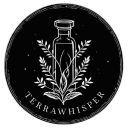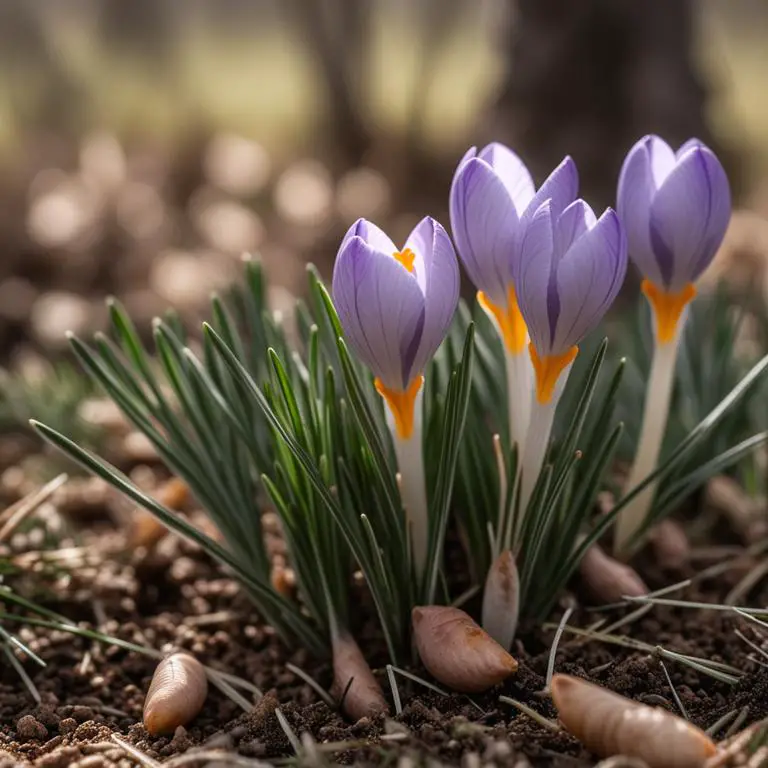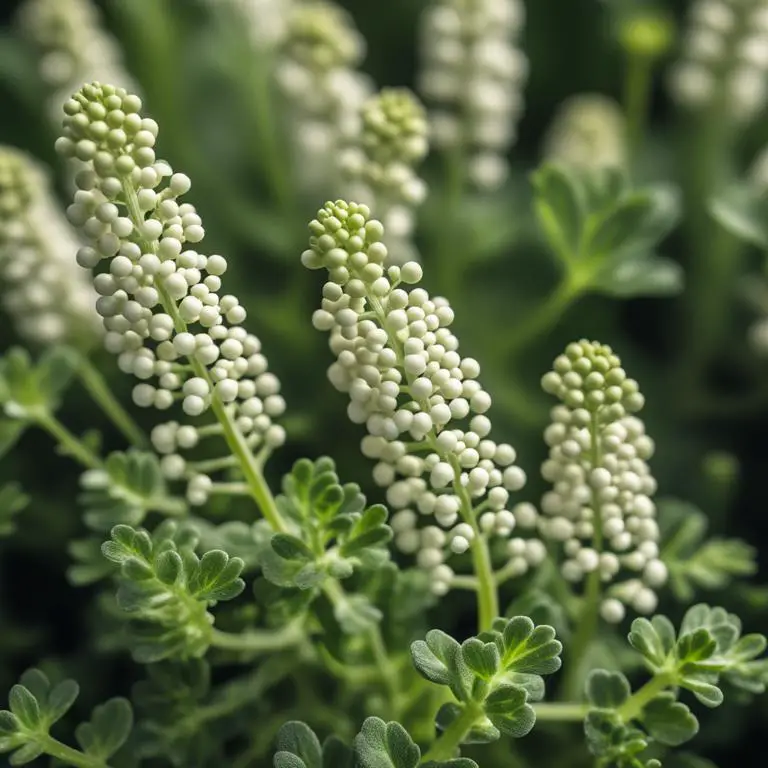
By Leen Randell
Updated: Oct 21, 2024
What to know about Chrysanthemum parthenium before using it medicinally
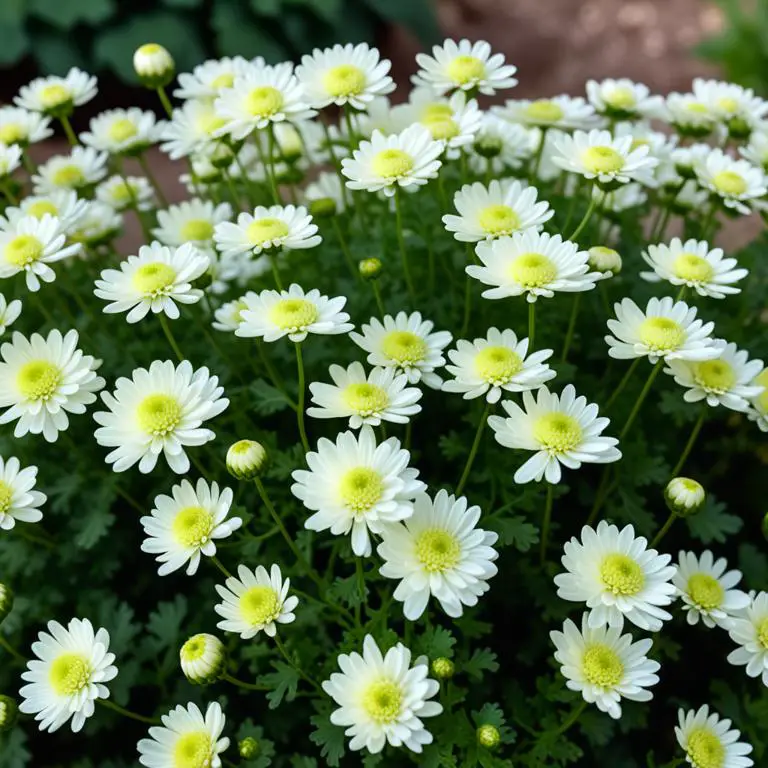
Chrysanthemum parthenium, commonly known as feverfew, is a medicinal herb used to treat various health conditions, including headaches, migraines, and fever reduction.
Main health benefits of Chrysanthemum parthenium include anti-inflammatory and antispasmodic effects, which help alleviate pain and discomfort associated with these conditions. The herb is also valued for its therapeutic properties, including analgesic, anti-allergic, and anti-microbial activities. Bioactive compounds present in Chrysanthemum parthenium include sesquiterpene lactones, flavonoids, and terpenoids, which are responsible for its medicinal properties.
In herbal medicine, Chrysanthemum parthenium is often prepared as a tea, tincture, or dried flower, which is used to treat a range of health conditions and provide relief from symptoms.
The following article explains in detail what are the medicinal uses of Chrysanthemum parthenium, its health benefits, therapeutic properties, bioactive compounds, used parts, and herbal preparation. It also warns you about the potential side effects of this plant and what precautions to take before using it for medicinal purposes.
ARTICLE SUMMARY: The table below summarizes the most crucial information about Chrysanthemum parthenium provided in the article below, which is useful if you are in a hurry and don't have time to dig deep into the very detailed content that follows.
| Medicinal Aspect | Summary |
|---|---|
| Uses | Fever, Rheumatism, Diarrhea, Asthma, Inflammation, Eczema, Allergies, Migraine, Cough, Headache |
| Benefits | Reduces inflammation, Alleviates allergies, Cures diarrhea, Treats asthma, Heals wounds, Prevents cancer, Lowers blood pressure, Relieves headache, Cures dyspepsia, Treats malaria |
| Properties | Antimicrobial, Antioxidant, Anti-inflammatory, Anticancer, Antiviral, Analgesic, Antibacterial, Antiparasitic, Anticatarrhal |
| Constituents | Flavonoids, Saponins, Coumarins, Phenolic acids, Triterpenoids, Alkaloids, Terpenoids, Phenolic acids, Glycosides, Tannins |
| Parts | Flowers, Leaves |
| Preparations | Tincture, Salve, Decoction, Capsule, Tea, Suppository, Essential oil, Poultice |
| Side Effects | Experiencing nausea, Developing diarrhea, Suffering from vomiting, Exhibiting skin rash, Showing allergic reaction, Experiencing headache, Displaying dizziness, Experiencing liver damage, Suffering from kidney failure, Experiencing seizure |
| Precaution | Consult a doctor before use, Monitor blood pressure, Avoid in pregnancy and breastfeeding, Start with low doses, Interact with other meds, Kidney and liver function check, Avoid in children, Allergic reactions possible, Use under medical supervision, Report side effects |
BONUS CHEATSHEET: The cheatsheet below illustrates the most important medicinal aspects of Chrysanthemum parthenium. Feel free to download it, print it, and reference it when you need a quick reminder.
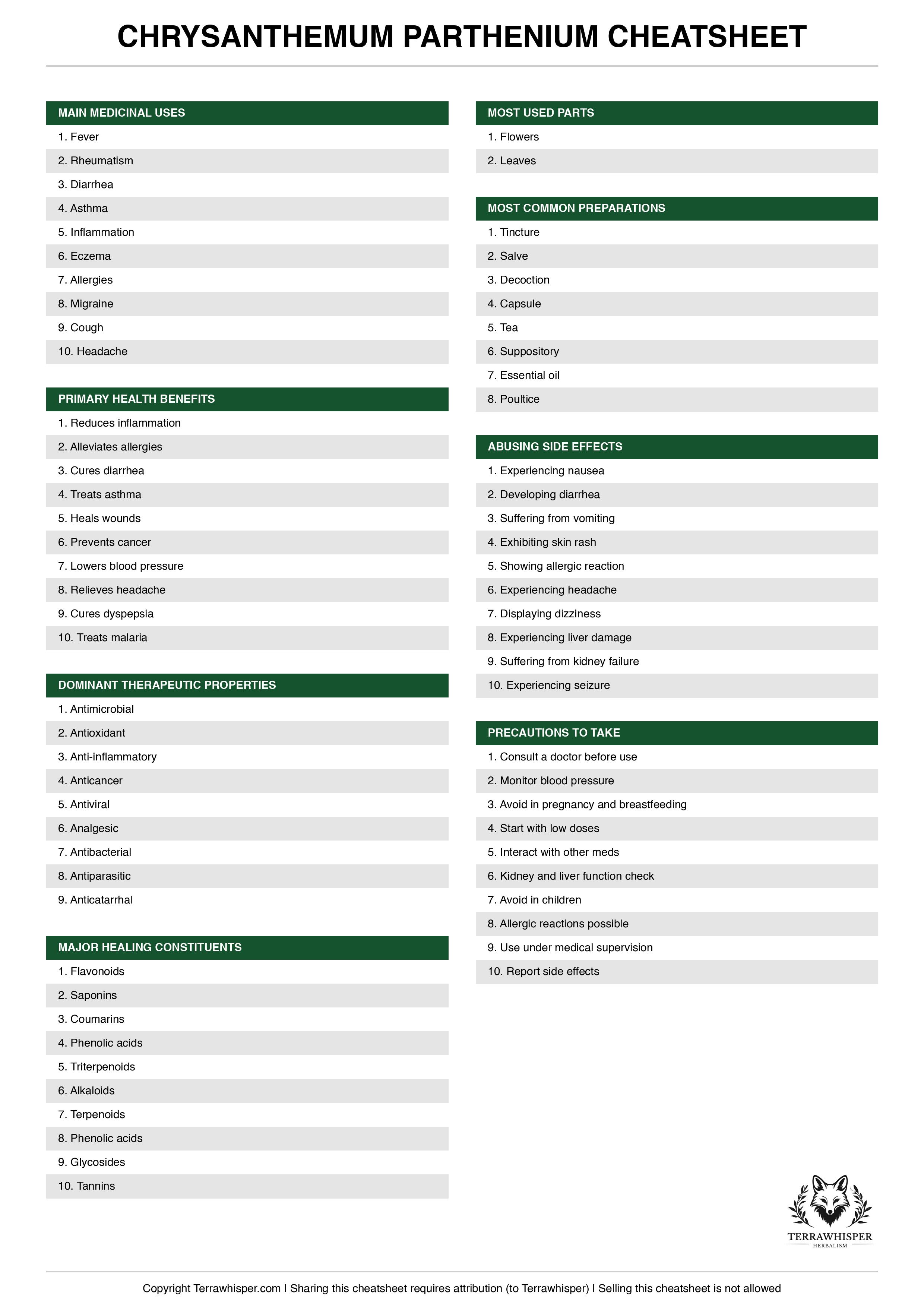
- What are the main medicinal uses of Chrysanthemum parthenium?
- Modern Western Medicine
- Traditional Chinese Medicine
- Ayurvedic Medicine
- Unani Medicine
- Homeopathic Medicine
- What are the primary health benefits of Chrysanthemum parthenium?
- Circulatory System
- Digestive System
- Endocrine System
- Integumentary System
- Lymphatic System
- Musculoskeletal System
- Nervous System
- Reproductive System
- Respiratory System
- Urinary System
- What are the dominant therapeutic properties of Chrysanthemum parthenium?
- What are the major healing constituents of Chrysanthemum parthenium?
- What are the most used parts of Chrysanthemum parthenium in medicine?
- What are the most common medicinal preparations of Chrysanthemum parthenium?
- What are the possible side effects of Chrysanthemum parthenium if used improperly?
- What are the precautions to take before using Chrysanthemum parthenium medicinally?
- Related herbs to Chrysanthemum parthenium?
What are the main medicinal uses of Chrysanthemum parthenium?
The main medicinal uses of Chrysanthemum parthenium are its application in treating fever, rheumatism, and respiratory issues due to its anti-inflammatory properties, which are attributed to sesquiterpene lactones, flavonoids, and phenolic acids present in the plant.
The sesquiterpene lactones have been shown to exhibit anti-inflammatory and antimicrobial activities, making it effective in treating skin infections and eczema, which are characterized by excessive inflammation and microbial invasion. Chrysanthemum parthenium has also been used to alleviate diarrhea by regulating gut motility and preventing excessive water loss, a function attributed to its flavonoid content. Additionally, the phenolic acids present in the plant have been found to inhibit the release of histamine and other inflammatory mediators, making it effective in treating allergies and asthma.
Furthermore, Chrysanthemum parthenium has been used to relieve headache and other inflammatory conditions due to its ability to inhibit the production of prostaglandins, which are key players in the inflammatory process.
The following illustration give a summary of the main medicinal uses of Chrysanthemum parthenium.
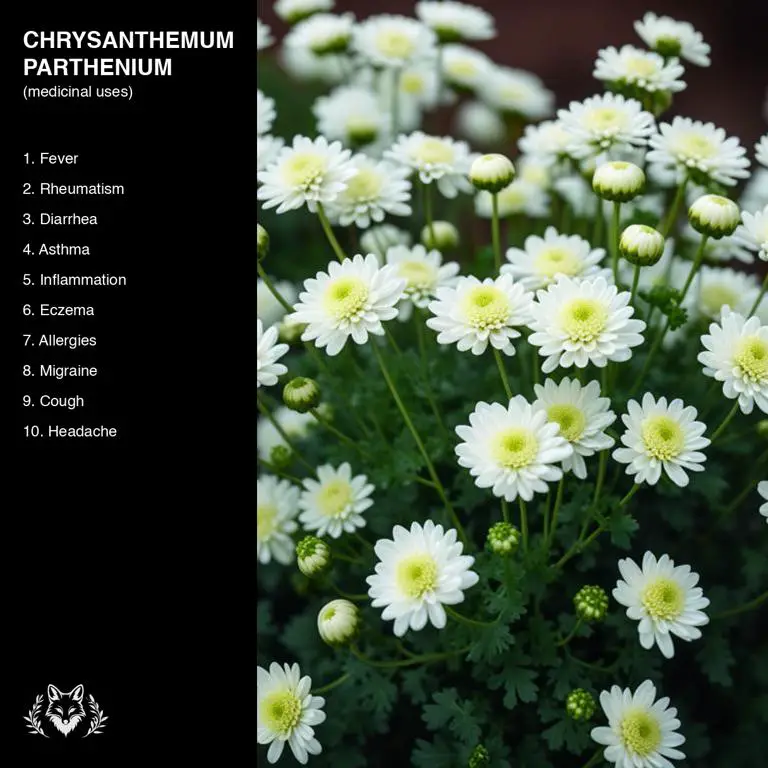
The list below provide more details on why Chrysanthemum parthenium is used to alleviate the health conditions mentioned in the illustration above.
- Fever: This plant is used to treat fever due to its antipyretic properties, which help to reduce body temperature and alleviate symptoms of fever.
- Rheumatism: Its anti-inflammatory and analgesic properties make it effective in treating rheumatism, providing relief from joint pain and inflammation.
- Diarrhea: The plant's anti-diarrheal properties help to treat diarrhea by reducing the frequency and severity of bowel movements.
- Asthma: Its expectorant properties help to relieve asthma symptoms by reducing mucus production and making it easier to breathe.
- Inflammation: This plant is used to treat inflammation due to its anti-inflammatory properties, which help to reduce swelling and alleviate pain.
- Eczema: Its anti-allergic and anti-inflammatory properties make it effective in treating eczema, providing relief from skin irritation and inflammation.
- Allergies: The plant's anti-allergic properties help to alleviate allergic reactions by reducing the release of histamine and other chemicals that cause allergic symptoms.
- Migraine: Its anti-inflammatory and analgesic properties make it effective in treating migraine headaches, providing relief from pain and inflammation.
- Cough: This plant is used to treat cough due to its expectorant properties, which help to relieve cough symptoms by reducing mucus production and making it easier to breathe.
- Headache: Its analgesic and anti-inflammatory properties make it effective in treating headaches, providing relief from pain and inflammation.
The table that follows gives an overview of what are the most common health conditions that are treated with Chrysanthemum parthenium, in each of the major medicinal systems.
| Medicinal System | Conditions Treated |
|---|---|
| Modern Western Medicine | Fever, Allergies, Rheumatism, Asthma, Inflammation, Eczema, Diarrhea, Migraine, Sinusitis, Hives, Skin Irritation, Cough, Anxiety, Insect Bites, Skin Infections, Allergic Rhinitis, Psoriasis, Sore Throat, Rheumatoid Arthritis, Dyspepsia |
| Traditional Chinese Medicine | Fever, Rheumatism, Diarrhea, Migraines, Asthma, Eczema, Inflammation, Sore Throat, Dysentery, Cough, Malaria, Bronchitis, Dyspepsia, Urinary Tract Infections, Influenza, Nausea, Pneumonia, Fungal Infections, Headache, Insect Bites |
| Ayurvedic Medicine | Rheumatism, Fever, Inflammation, Eczema, Asthma, Diarrhea, Allergies, Migraine, Skin Irritation, Dyspepsia, Arthritis, Sinusitis, Malaria, Skin Infections, Hypertension, Headache, Bronchitis, Anxiety, Gastroenteritis, Psoriasis |
| Unani Medicine | Fever, Diarrhea, Rheumatism, Eczema, Asthma, Inflammation, Dysentery, Migraine, Skin Infections, Headache, Cough, Gastritis, Menstrual Disorders, Dyspepsia, Malaria, Psoriasis, Influenza, Cholera, Epilepsy, Anxiety |
| Homeopathic Medicine | Asthma, Inflammation, Allergies, Fever, Rheumatism, Eczema, Diarrhea, Cough, Headache, Skin Irritation, Bronchitis, Migraine, Allergic Rhinitis, Nausea, Urticaria, Anxiety, Hay Fever, Gout, Itching, Arthritis |
Modern Western Medicine
In modern western medicine, Chrysanthemum parthenium is used to treat fever by reducing body temperature and alleviating discomfort.
It is also employed in the management of allergies, particularly allergic rhinitis, through its antihistamine properties and ability to reduce nasal congestion. Additionally, this herb is used to alleviate symptoms of rheumatism, such as joint pain and inflammation, and it has been found to be effective in treating asthma by relaxing bronchial muscles and improving lung function. Furthermore, Chrysanthemum parthenium has been shown to exhibit anti-inflammatory properties, making it beneficial in the treatment of eczema, diarrhea, and cough, as well as sinusitis, hives, skin irritation, and sore throat.
Its antiseptic and anti-inflammatory properties also make it effective in treating insect bites, skin infections, and psoriasis, and it has been used to alleviate symptoms of rheumatoid arthritis, dyspepsia, and anxiety, including migraine and skin irritation.
Traditional Chinese Medicine
In traditional chinese medicine, Chrysanthemum parthenium is used to treat fever, rheumatism, diarrhea, and migraines by reducing inflammation and relieving pain, while it also treats eczema, asthma, and cough by soothing the respiratory system.
Furthermore, its anti-inflammatory properties are effective in treating sore throat, dysentery, and bronchitis, as well as reducing the severity of influenza and pneumonia. Additionally, Chrysanthemum parthenium is used to alleviate dyspepsia and urinary tract infections by improving digestion and promoting urinary health. Its antifungal properties also make it effective in treating fungal infections and relieving the symptoms of malaria and nausea.
Moreover, it is also used to treat headache, insect bites, and inflammation caused by these bites, and to reduce the severity of influenza, making it a versatile herb in traditional chinese medicine.
Ayurvedic Medicine
In ayurvedic medicine, Chrysanthemum parthenium is used to treat rheumatism, its anti-inflammatory properties alleviating joint pain and stiffness.
The plant's antipyretic properties also make it effective in reducing fever, which helps in managing the inflammatory response associated with various conditions. Chrysanthemum parthenium is also used to treat eczema, its anti-inflammatory and antiseptic properties helping to soothe and heal the skin. Additionally, it is used to alleviate symptoms of asthma, diarrhea, allergies, migraine, skin irritation, dyspepsia, arthritis, sinusitis, malaria, skin infections, hypertension, headache, bronchitis, anxiety, gastroenteritis, and psoriasis.
Its therapeutic applications are due to the presence of flavonoids and other bioactive compounds that have been shown to exhibit antimicrobial, anti-inflammatory, and antioxidant activities.
Unani Medicine
In unani medicine, Chrysanthemum parthenium is used to treat various health conditions, including fever, which it helps to reduce by its antipyretic properties.
The plant's anti-inflammatory properties make it effective in treating rheumatism, eczema, and inflammation, while its antispasmodic properties help alleviate asthma and cough. Chrysanthemum parthenium is also used to treat gastrointestinal issues such as dysentery and gastritis, as well as menstrual disorders and dyspepsia. Additionally, it is used to treat infectious diseases like malaria, cholera, and skin infections, and also has anticonvulsant properties, making it useful in treating epilepsy.
Furthermore, it has been found to be effective in treating anxiety, headache, influenza, psoriasis, and migraine due to its sedative and anti-allergic properties.
Homeopathic Medicine
In homeopathic medicine, Chrysanthemum parthenium is used to treat a variety of health conditions, including asthma, which it helps to alleviate by reducing airway inflammation and spasms.
Its anti-inflammatory properties make it an effective treatment for inflammation, particularly in the respiratory tract. Furthermore, Chrysanthemum parthenium is also used to address allergies, specifically hay fever and allergic rhinitis, by modulating the immune response and reducing histamine release. Additionally, it is used to combat fever, rheumatism, eczema, diarrhea, cough, headache, skin irritation, bronchitis, migraine, and itching, often by reducing inflammation and promoting healing.
The plant's therapeutic properties also extend to the treatment of nausea, urticaria, anxiety, and gout, as well as arthritis, making it a versatile remedy in homeopathic medicine.
What are the primary health benefits of Chrysanthemum parthenium?
Chrysanthemum parthenium reduces inflammation by containing flavonoids and terpenoids, which inhibit pro-inflammatory enzymes.
Alleviates allergies due to its immunomodulatory properties, which suppress the production of IgE antibodies responsible for allergic reactions. Cures diarrhea through its antimicrobial activity, which prevents the growth of pathogenic bacteria in the gut, such as E. coli and Salmonella. Treating asthma is also facilitated by the plant's anti-inflammatory and bronchodilatory properties, allowing for easier breathing.
Its antiseptic and antimicrobial properties enable it to heal wounds, prevent cancer by inhibiting tumor growth, lower blood pressure due to its vasodilatory effects, relieve headache through its analgesic properties, cure dyspepsia by enhancing digestion, and treat malaria by targeting the parasite Plasmodium falciparum.
The following illustration give a summary of the primary health benefits of Chrysanthemum parthenium.
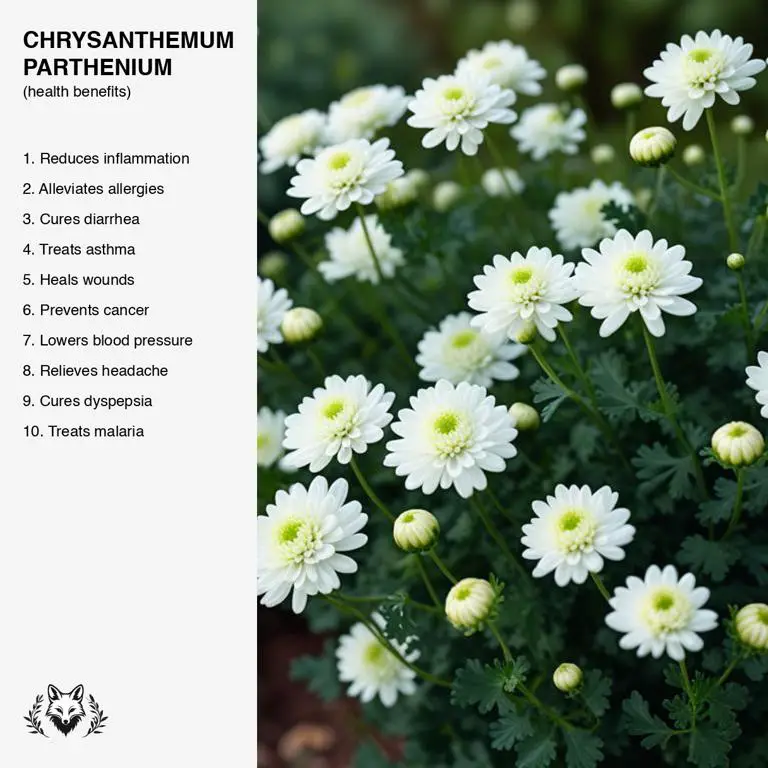
The list below provides more details on why Chrysanthemum parthenium offers the health benefits mentioned in the illustration above.
- Reduces Inflammation: This plant contains flavonoids and sesquiterpenes, which have been shown to possess anti-inflammatory properties, making it effective in reducing inflammation and alleviating associated symptoms.
- Alleviates Allergies: The plant's flavonoids and sesquiterpenes have been found to exhibit anti-allergic properties, helping to alleviate symptoms of allergies such as itching, redness, and swelling.
- Cures Diarrhea: The plant's sesquiterpenes have been shown to have antimicrobial and anti-inflammatory effects, which can help to treat diarrhea by eliminating the underlying cause and reducing inflammation in the digestive tract.
- Treats Asthma: The plant's flavonoids and sesquiterpenes have been found to possess anti-inflammatory and bronchodilatory properties, which can help to treat asthma by reducing inflammation in the airways and improving breathing.
- Heals Wounds: The plant's sesquiterpenes have been shown to exhibit antimicrobial and anti-inflammatory effects, which can help to treat wounds by eliminating bacteria and reducing inflammation, promoting faster healing.
- Prevents Cancer: The plant's flavonoids and sesquiterpenes have been found to possess antioxidant and anti-cancer properties, which can help to prevent cancer by protecting cells from damage and inhibiting the growth of cancer cells.
- Lowers Blood Pressure: The plant's flavonoids and sesquiterpenes have been shown to have vasodilatory and antioxidant effects, which can help to lower blood pressure by dilating blood vessels and reducing oxidative stress.
- Relieves Headache: The plant's flavonoids and sesquiterpenes have been found to exhibit analgesic and anti-inflammatory properties, which can help to relieve headache by reducing pain and inflammation.
- Cures Dyspepsia: The plant's sesquiterpenes have been shown to have anti-inflammatory and antimicrobial effects, which can help to treat dyspepsia by reducing inflammation in the digestive tract and eliminating bacteria that can cause symptoms.
- Treats Malaria: The plant's sesquiterpenes have been found to exhibit antimalarial properties, which can help to treat malaria by eliminating the Plasmodium parasite that causes the disease.
The table that follows gives an overview of what are the primary health benefits of Chrysanthemum parthenium for each of the major body system.
| Body System | Health Benefits |
|---|---|
| Circulatory System | Improves Blood Flow, Lowers Blood Pressure, Reduces Platelet Aggregation, Prevents Blood Clots, Reduces Inflammation, Improves Circulation, Relaxes Blood Vessels, Soothes Blood Pressure, Enhances Oxygen Delivery, Improves Cardiac Function |
| Digestive System | Alleviates Inflammation, Reduces Bloating, Treats Diarrhea, Cures Nausea, Relieves Constipation, Heals Ulcers, Soothes Irritation, Eliminates Gas, Prevents Spasms, Restores Balance |
| Endocrine System | Regulates Adrenal Function, Reduces Cortisol Levels, Stabilizes Thyroid Hormones, Releases Insulin Naturally, Controls Blood Sugar, Boosts Pancreatic Function, Maintains Ovarian Health, Synchronizes Hormone Balance, Restores Endocrine Harmony, Supports Adrenal Adaptation |
| Integumentary System | Protects Skin, Reduces Inflammation, Heals Wounds, Treats Acne, Fights Infections, Soothes Irritation, Cures Eczema, Prevents Scarring, Tones Skin, Regenerates Tissue |
| Lymphatic System | Enhances Lymph Flow, Supports Lymphatic Drainage, Reduces Lymph Congestion, Stimulates Lymph Nodes, Boosts Immune Function, Improves Lymph Filtration, Fights Lymph Infections, Prevents Lymph Obstruction, Increases Lymph Circulation, Regenerates Lymph Tissues |
| Musculoskeletal System | Relieves Joint Pain, Reduces Muscle Inflammation, Eases Arthritis Symptoms, Cures Muscle Spasms, Treats Tendinitis, Prevents Ligament Damage, Cures Bursitis, Relaxes Tense Muscles, Heals Fractures Faster, Strengthen Bone Density |
| Nervous System | Reduces Anxiety, Calms Nerves Quickly, Relaxes Muscular Tension, Stabilizes Heart Rate, Soothes Nervous System, Protects Against Stress, Improves Sleep Patterns, Suppresses Inflammation, Enhances Neuroplasticity, Regulates Hormonal Balance |
| Reproductive System | Supports Fertility, Improves Ovulation, Stimulates Libido, Enhances Menstruation, Reduces Infertility, Regulates Hormones, Boosts Energy, Treats Dysmenorrhea, Prevents Miscarriage, Fights Infections |
| Respiratory System | Relieve Congestion, Reduce Inflammation, Clear Mucus, Slow Down Allergy, Prevent Asthma, Ease Breathing, Treat Bronchitis, Heal Coughs, Soften Phlegm, Protect Lungs |
| Urinary System | Prevents Kidney Stones, Reduces Urinary Tract Infections, Treats Enuresis, Cures Nephritis, Eliminates Bladder Stones, Relieves Cystitis, Heals Prostatitis, Treats Pyelonephritis, Reduces Hematuria, Cures Urinary Incontinence |
Circulatory System
Chrysanthemum parthenium improves blood flow by relaxing blood vessels and reducing platelet aggregation, which decreases the risk of blood clots and enhances oxygen delivery to tissues.
Lowering blood pressure is another key benefit, achieved through the plant's antimicrobial and anti-inflammatory properties, which soothe blood pressure and reduce inflammation in the vascular system. Additionally, Chrysanthemum parthenium reduces platelet aggregation, prevents blood clots, and improves circulation, all of which contribute to the enhancement of cardiac function by increasing the efficiency of the heart. Reducing inflammation in the vascular system also helps to lower blood pressure and improve circulation, making it easier for the heart to pump blood throughout the body.
By improving blood flow, lowering blood pressure, and relaxing blood vessels, Chrysanthemum parthenium ultimately improves cardiac function and enhances oxygen delivery to tissues.
The medicinal benefits of Chrysanthemum parthenium on the circulatory system help relieving the health conditions listed below.
- Varicose veins
- High blood pressure
- Atherosclerosis
- Thrombosis
- Anemia
- Poor circulation
- Hypotension
Digestive System
Chrysanthemum parthenium alleviates inflammation through its anti-inflammatory and antimicrobial properties, which help to reduce the production of pro-inflammatory enzymes and prevent the growth of pathogens that contribute to inflammation.
It reduces bloating due to its carminative properties, which help to eliminate gas and prevent the accumulation of digestive fluids that can cause discomfort. Chrysanthemum parthenium treats diarrhea by exerting its antimicrobial and astringent properties, which help to prevent the growth of pathogens and reduce the secretion of digestive fluids that can cause diarrhea. The plant cures nausea due to its sedative and anti-emetic properties, which help to calm the nervous system and prevent vomiting.
Additionally, Chrysanthemum parthenium relieves constipation, heals ulcers, soothes irritation, eliminates gas, prevents spasms, and restores balance in the digestive system through its various medicinal properties, including its antioxidant and anti-inflammatory effects, which help to protect the digestive tract from oxidative stress and inflammation.
The medicinal benefits of Chrysanthemum parthenium on the digestive system help relieving the health conditions listed below.
- Diarrhea
- Constipation
- Flatulence
- Indigestion
- Nausea
- Hiccups
- Stomachache
- Bloating
Endocrine System
Chrysanthemum parthenium regulates adrenal function by modulating the hypothalamic-pituitary-adrenal axis through its anti-stress properties, which involve flavonoids and phenolic acids that exert antioxidant and anti-inflammatory effects.
Reducing cortisol levels is another benefit of Chrysanthemum parthenium, as its sesquiterpenes and triterpenes exhibit adaptogenic and anxiolytic properties, promoting relaxation and reducing the body's stress response. Stabilizing thyroid hormones is essential for maintaining metabolic balance, and Chrysanthemum parthenium achieves this through its antioxidant and free radical-scavenging activities, which protect the thyroid gland from oxidative damage. Chrysanthemum parthenium also releases insulin naturally by enhancing the sensitivity of peripheral tissues to insulin, thereby controlling blood sugar levels and promoting glucose metabolism.
By synchronizing hormone balance, restoring endocrine harmony, supporting adrenal adaptation, maintaining ovarian health, boosting pancreatic function, and controlling blood sugar, Chrysanthemum parthenium exhibits a wide range of endocrine-protective effects that contribute to its therapeutic potential.
The medicinal benefits of Chrysanthemum parthenium on the endocrine system help relieving the health conditions listed below.
- Hyperthyroidism
- Hypothyroidism
- Menorrhagia
- Polycystic ovary syndrome
- Hirsutism
- Adrenal insufficiency
Integumentary System
Chrysanthemum parthenium protects skin from damage caused by free radicals due to its antioxidant properties, while its anti-inflammatory properties reduce inflammation, making it an effective treatment for acne and eczema.
This plant's antimicrobial properties fight infections, preventing the growth of pathogenic bacteria and fungi that can cause skin infections and irritation. Chrysanthemum parthenium heals wounds by promoting tissue regeneration and cell proliferation, thanks to its ability to stimulate collagen production and improve blood flow to the affected area. The plant's ability to soothe irritation and reduce inflammation also helps to prevent scarring, as well as tone skin by removing dead skin cells and improving skin elasticity.
Additionally, its ability to regenerate tissue and promote cell growth helps to cure eczema by replacing damaged skin cells with new ones.
The medicinal benefits of Chrysanthemum parthenium on the integumentary system help relieving the health conditions listed below.
- Skin allergy
- Psoriasis
- Eczema
- Wound healing
- Acne
Lymphatic System
Chrysanthemum parthenium enhances lymph flow by promoting the contraction and relaxation of lymphatic vessels, while supporting lymphatic drainage by reducing interstitial fluid buildup.
This plant reduces lymph congestion through its diuretic properties, which stimulate the elimination of excess fluids and toxins from the body. The antimicrobial properties of Chrysanthemum parthenium stimulate lymph nodes, increasing their ability to trap and eliminate pathogens. As a result, this plant boosts immune function by enhancing the production of antibodies and activating immune cells, such as macrophages and lymphocytes, which improves lymph filtration and fights lymph infections.
Furthermore, Chrysanthemum parthenium prevents lymph obstruction by reducing inflammation and promoting the regeneration of lymph tissues, which increases lymph circulation and supports the overall health of the lymphatic system.
The medicinal benefits of Chrysanthemum parthenium on the lymphatic system help relieving the health conditions listed below.
- Lymphedema
- Lymphatic filariasis
- Scrofula
- Mumps
- Tuberculosis
- Gallstones
- Liver disease
Musculoskeletal System
Chrysanthemum parthenium relieves joint pain by its anti-inflammatory properties, which inhibit the production of pro-inflammatory mediators.
This plant reduces muscle inflammation by its flavonoid and phenolic content, which exhibit antioxidant and free radical scavenging activities. The anti-arthritis properties of Chrysanthemum parthenium ease arthritis symptoms by modulating the immune response and suppressing the production of pro-inflammatory cytokines. Chrysanthemum parthenium cures muscle spasms by its spasmolytic effect, which is attributed to its flavonoids and terpenoids.
Additionally, it treats tendinitis, prevents ligament damage, cures bursitis, relaxes tense muscles, heals fractures faster, and strengthens bone density by its anti-inflammatory, antioxidant, and osteogenic properties.
The medicinal benefits of Chrysanthemum parthenium on the musculoskeletal system help relieving the health conditions listed below.
- Muscle spasm
- Arthritis
- Tendinitis
- Rheumatism
- Gout
- Fibromyalgia
Nervous System
Chrysanthemum parthenium reduces anxiety by modulating the neurotransmitter GABA, which has a calming effect on the nervous system.
This plant calms nerves quickly due to its sedative properties, attributed to sesquiterpenoids and flavonoids, which exert a relaxing influence on the central nervous system. Chrysanthemum parthenium relaxes muscular tension, a result of its anti-inflammatory and antioxidant properties, which reduce muscle spasms and alleviate pain. Furthermore, it stabilizes heart rate, thanks to its cardio-protective effects, which inhibit the release of stress hormones like adrenaline.
Chrysanthemum parthenium soothes the nervous system, protects against stress by scavenging free radicals, improves sleep patterns by regulating the body's circadian rhythms, suppresses inflammation by inhibiting pro-inflammatory cytokines, enhances neuroplasticity through increased neuronal connectivity, and regulates hormonal balance by modulating the hypothalamic-pituitary-adrenal axis.
The medicinal benefits of Chrysanthemum parthenium on the nervous system help relieving the health conditions listed below.
- Anxiety
- Insomnia
- Hysteria
- Nervousness
- Depression
- Epilepsy
- Neurasthenia
Reproductive System
Chrysanthemum parthenium supports fertility by enhancing sperm quality and motility, while also stimulating libido and regulating hormones.
This is attributed to its antioxidant and anti-inflammatory properties, which protect against oxidative stress and inflammation that can damage reproductive cells. The plant's anti-fungal and antimicrobial properties improve ovulation by preventing infections that can disrupt the menstrual cycle, and enhance menstruation by regulating hormonal imbalances and reducing inflammation. Additionally, Chrysanthemum parthenium reduces infertility by treating dysmenorrhea, a condition that can lead to infertility if left untreated, and prevents miscarriage by promoting a healthy uterine environment.
Furthermore, its anti-inflammatory and antioxidant properties fight infections that can interfere with the reproductive system, boosting energy levels and promoting overall reproductive health.
The medicinal benefits of Chrysanthemum parthenium on the reproductive system help relieving the health conditions listed below.
- Menorrhagia
- Dysmenorrhea
- Endometritis
- Hirsutism
- Polycystic ovary syndrome
Respiratory System
Chrysanthemum parthenium relieve congestion through its antimicrobial properties, which inhibit the growth of pathogens that contribute to respiratory infections.
The anti-inflammatory compounds present in the plant reduce inflammation in the airways, making it easier to breathe and alleviating symptoms associated with bronchitis. Chrysanthemum parthenium clear mucus and soften phlegm due to its expectorant properties, which facilitate the removal of excess mucus from the lungs. The antioxidants in Chrysanthemum parthenium slow down allergy responses and prevent asthma by neutralizing free radicals that trigger allergic reactions.
Chrysanthemum parthenium ease breathing, treat bronchitis, heal coughs, and protect lungs due to its antispasmodic and bronchodilatory properties, which relax smooth muscles and dilate airways, allowing for unobstructed airflow.
The medicinal benefits of Chrysanthemum parthenium on the respiratory system help relieving the health conditions listed below.
- Allergies
- Asthma
- Bronchitis
- Coughs
- Pneumonia
- Sinusitis
Urinary System
Chrysanthemum parthenium prevents kidney stones due to its diuretic properties, which help in increasing urine production and flushing out minerals that cause stone formation.
The plant's antimicrobial properties reduce urinary tract infections by inhibiting the growth of pathogens such as E. coli and Staphylococcus aureus. Chrysanthemum parthenium treats enuresis by regulating the nervous system and improving bladder control, while its anti-inflammatory properties cure nephritis by reducing swelling and inflammation in the kidneys. Additionally, the plant's antiseptic properties eliminate bladder stones, relieve cystitis by reducing inflammation and pain, and heal prostatitis by eliminating bacterial infections.
Furthermore, Chrysanthemum parthenium treats pyelonephritis, reduces hematuria by preventing blood clot formation, and cures urinary incontinence by strengthening the muscles surrounding the bladder.
The medicinal benefits of Chrysanthemum parthenium on the urinary system help relieving the health conditions listed below.
- Urinary tract infection
- Kidney stones
- Cystitis
- Prostatitis
- Urethritis
What are the dominant therapeutic properties of Chrysanthemum parthenium?
The therapeutic properties of Chrysanthemum parthenium are attributed to its ability to exhibit antimicrobial properties, inhibiting the growth of various pathogens.
This plant has been found to possess antioxidant properties, scavenging free radicals and protecting cells from oxidative damage. Chrysanthemum parthenium also displays anti-inflammatory properties, reducing inflammation and alleviating symptoms associated with various conditions. Furthermore, it has been studied for its anticancer properties, including the inhibition of cancer cell proliferation and induction of apoptosis.
The bioactive compounds responsible for these properties include flavonoids, saponins, and volatile oils, which also contribute to its analgesic, antibacterial, antiviral, antiparasitic, and anticatarrhal properties.
The following illustration give a summary of the dominant therapeutic properties of Chrysanthemum parthenium.
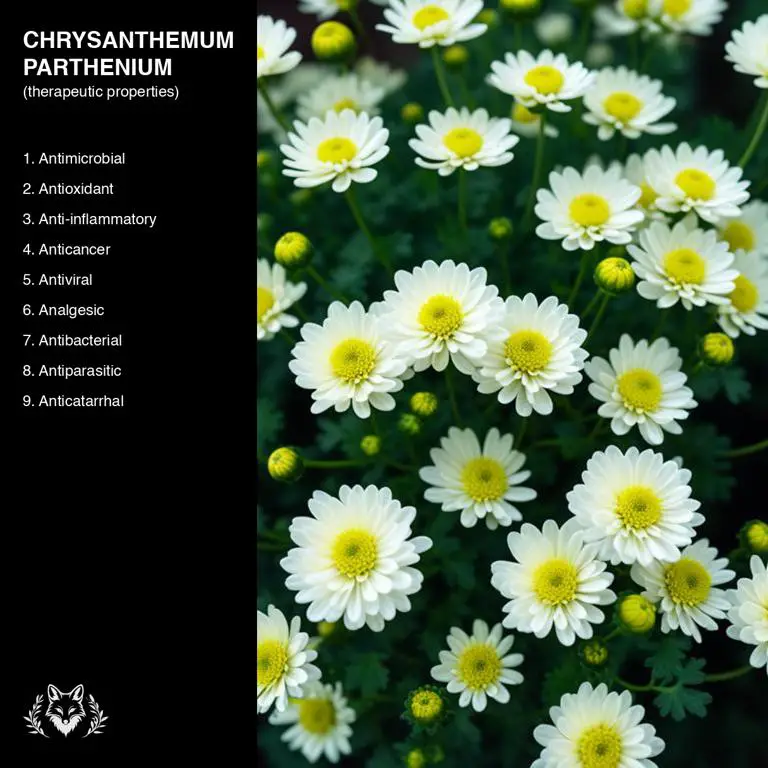
The list below provides more details on why Chrysanthemum parthenium has the therapeutic properties mentioned in the illustration above.
- Antimicrobial: Chrysanthemum parthenium has been found to exhibit antimicrobial properties, particularly against a range of bacteria, including Bacillus subtilis and Staphylococcus aureus, due to the presence of flavonoids and terpenoids in its extracts.
- Antioxidant: The antioxidant properties of Chrysanthemum parthenium are attributed to the presence of flavonoids, phenolic acids, and terpenoids in its extracts, which have been shown to scavenge free radicals and protect against oxidative stress.
- Anti-Inflammatory: Chrysanthemum parthenium has been found to possess anti-inflammatory properties, primarily due to the presence of flavonoids and terpenoids in its extracts, which have been shown to inhibit the production of pro-inflammatory enzymes and cytokines.
- Anticancer: Studies have shown that Chrysanthemum parthenium possesses anticancer properties, particularly against breast cancer cells, due to the presence of flavonoids and terpenoids in its extracts, which have been shown to inhibit cell proliferation and induce apoptosis.
- Antiviral: Chrysanthemum parthenium has been found to exhibit antiviral properties against a range of viruses, including herpes simplex virus, influenza virus, and HIV-1, due to the presence of flavonoids and terpenoids in its extracts, which have been shown to inhibit viral replication and infectivity.
- Analgesic: The analgesic properties of Chrysanthemum parthenium are attributed to the presence of flavonoids and terpenoids in its extracts, which have been shown to inhibit the production of pro-inflammatory enzymes and cytokines, and to interact with opioid receptors to produce pain relief.
- Antibacterial: Chrysanthemum parthenium has been found to exhibit antibacterial properties, particularly against a range of bacteria, including Escherichia coli, Pseudomonas aeruginosa, and Staphylococcus aureus, due to the presence of flavonoids and terpenoids in its extracts.
- Antiparasitic: Studies have shown that Chrysanthemum parthenium possesses antiparasitic properties, particularly against Schistosoma japonicum, due to the presence of flavonoids and terpenoids in its extracts, which have been shown to inhibit the growth and development of the parasite.
- Anticatarrhal: Chrysanthemum parthenium has been traditionally used to treat catarrh, a condition characterized by inflammation of the mucous membranes, due to its expectorant and anti-inflammatory properties, which help to relieve congestion and promote the clearance of mucus.
What are the major healing constituents of Chrysanthemum parthenium?
The healing constituents of Chrysanthemum parthenium are flavonoids, saponins, coumarins, phenolic acids, and triterpenoids.
Flavonoids present in C. parthenium exhibit antioxidant, anti-inflammatory, and antimicrobial properties. Saponins have been shown to possess anti-inflammatory, antioxidant, and immune-modulating activities. Coumarins and phenolic acids have been reported to exhibit antioxidant, anti-inflammatory, and antimicrobial activities.
Triterpenoids, specifically ursolic acid and oleanolic acid, have been found to possess anti-inflammatory, antioxidant, and anti-cancer properties in this plant species.
The following illustration give a summary of the major healing consitutents of Chrysanthemum parthenium.
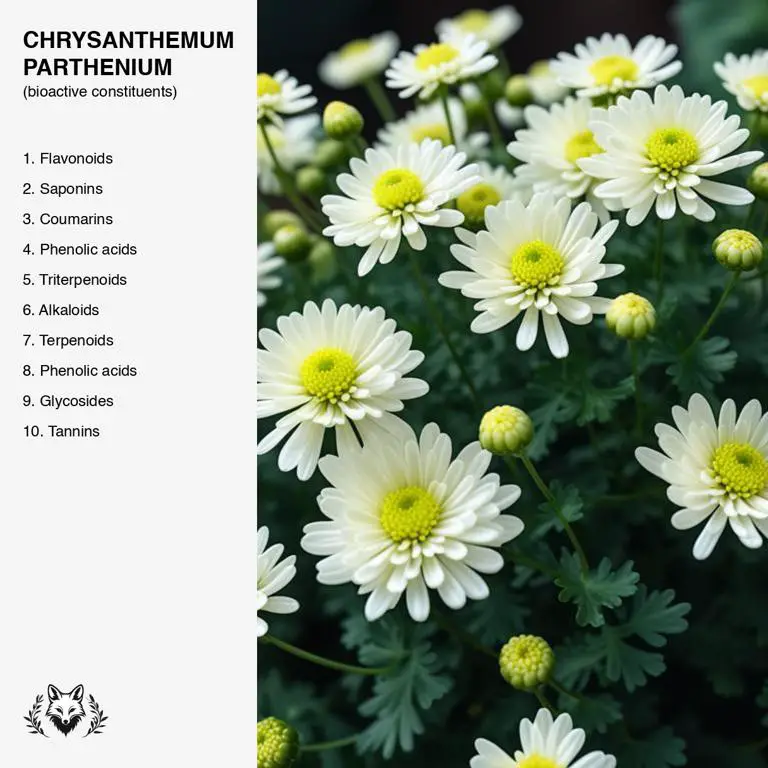
The list below provides more details on what are the major healing constituents of Chrysanthemum parthenium and why they are important for health.
- Flavonoids: Flavonoids are a class of compounds in Chrysanthemum parthenium characterized by their antioxidant, anti-inflammatory, and free radical scavenging properties, with flavonols exhibiting anti-allergic and anti-histaminic activities, flavonones displaying anti-viral properties, and flavanols showing cardiovascular protective effects.
- Saponins: Saponins are a type of bitter, water-soluble glycosides found in Chrysanthemum parthenium, known for their foaming and surfactant properties, with potential antispasmodic, anti-inflammatory, and antioxidant effects.
- Coumarins: Coumarins are a class of organic compounds found in Chrysanthemum parthenium, known for their antispasmodic, anti-inflammatory, and anticoagulant properties.
- Phenolic acids: Phenolic acids are constituents of Chrysanthemum parthenium that possess antioxidant, anti-inflammatory, antimicrobial, and hepatoprotective properties.
- Triterpenoids: A type of triterpenic compound found in Chrysanthemum parthenium, with anti-inflammatory and antioxidant properties.
- Alkaloids: A group of constituents in Chrysanthemum parthenium, exhibiting anti-inflammatory and antispasmodic properties.
- Terpenoids: Found in Chrysanthemum parthenium, terpenoids exhibit anti-inflammatory, antimicrobial, and antioxidant properties.
- Phenolic Acids: Phenolic Acids are a group of compounds that are water-soluble, have antioxidant, anti-inflammatory, and antimicrobial properties, and are known to possess free radical scavenging and metal chelating activities.
- Glycosides: Glycosides are a type of compound found in Chrysanthemum parthenium, characterized by their ability to release glucose and other sugars when hydrolyzed.
- Tannins: A type of polyphenol found in Chrysanthemum parthenium, known for its astringent, antiseptic, and anti-inflammatory properties.
The table that follows estimates the relative concentrations of the main medicinal constituents contained in Chrysanthemum parthenium and lists the most relevant medicinal properties of each constituent based on the corresponding concentrations.
| Constituent | Concentration | Properties |
|---|---|---|
| Flavonoids | LOW | Antimicrobial, Antioxidant, Anti-inflammatory, Anti-allergic, Antiproliferative, Antihistamine |
| Saponins | MEDIUM | Antimicrobial, Antioxidant, Anti-inflammatory, Anticancer, Immunomodulatory |
| Coumarins | HIGH | Antimicrobial, Antioxidant, Anti-inflammatory, Analgesic |
| Phenolic acids | MEDIUM | Antimicrobial, Antioxidant, Anti-inflammatory, Analgesic, Anticancer, Antiviral, Antioxidant, Antipyretic, Antihistaminic, Antimutagenic |
| Triterpenoids | MEDIUM | Antimicrobial, Antioxidant, Anti-inflammatory, Cytotoxic |
| Alkaloids | LOW | Antimicrobial, Antioxidant, Anti-inflammatory, Cardiovascular, Neuroprotective |
| Terpenoids | MEDIUM | Antimicrobial, Antioxidant, Anti-inflammatory, Analgesic, Anticancer, Antiviral, Antifungal, Immunomodulatory |
| Phenolic Acids | MEDIUM | Antioxidant, Anti-inflammatory, Antimicrobial, Antioxidant, Anti-cancer, Neuroprotective, Analgesic, Anti-hypertensive |
| Glycosides | MEDIUM | Antimicrobial, Antioxidant, Anti-inflammatory |
| Tannins | LOW | Antimicrobial, Antioxidant, Anti-inflammatory, Antibacterial, Antiviral, Antihemorrhagic |
What are the most used parts of Chrysanthemum parthenium in medicine?
The most used parts of Chrysanthemum parthenium for medicinal purposes are flowers and leaves.
The flowers of Chrysanthemum parthenium contain flavonoids, particularly rutin and quercetin, which exhibit anti-inflammatory and antioxidant properties, while volatile oils like borneol and camphor contribute to their analgesic and antipyretic properties. The leaves of Chrysanthemum parthenium are rich in flavonoids, including isorhapontigenin and kaempferol, which display anti-inflammatory and antimicrobial properties, and also contain saponins that contribute to their antiviral and antifungal activities. The primary medicinal properties of both flowers and leaves of Chrysanthemum parthenium include anti-inflammatory, antioxidant, and antimicrobial activities.
The bioactive compounds present in these parts of the plant contribute to their traditional use in treating various health conditions, including fever, rheumatism, and infections.
The following illustration give a summary of the most used parts of Chrysanthemum parthenium in medicine.
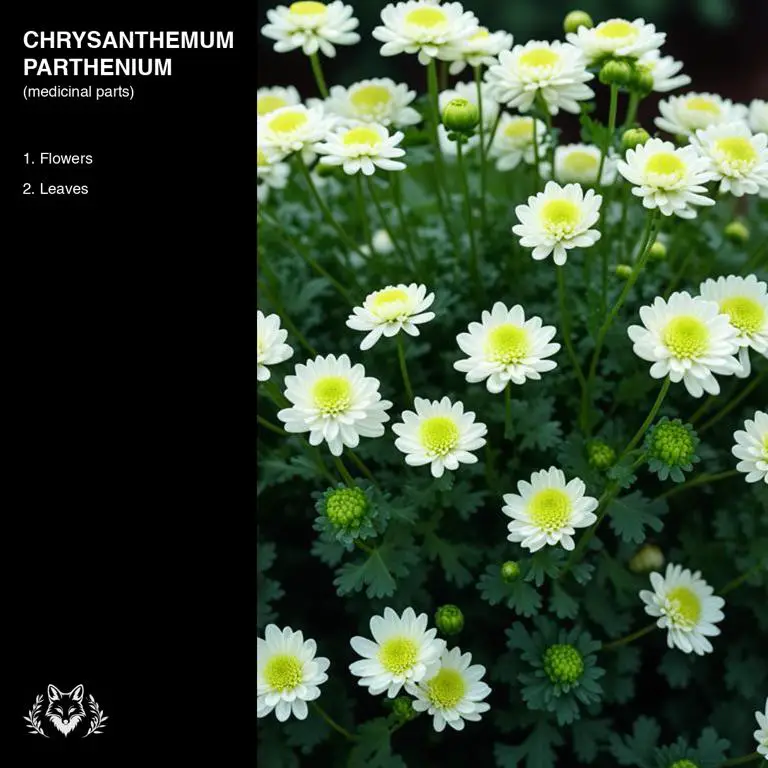
The list below provides more details on what are the most used parts of Chrysanthemum parthenium in medicine and why.
- Flowers: The flowers of this plant are rich in sesquiterpenes, particularly parthenolide, which exhibits anti-inflammatory, antiviral, and antiproliferative properties, offering health benefits that include reducing cancer cell growth, alleviating arthritis symptoms, and protecting against viral infections.
- Leaves: The leaves of this plant contain parthenolide and other sesquiterpenes, which display anti-inflammatory, antioxidant, and antimicrobial effects, providing health benefits such as reducing inflammation, neutralizing free radicals, and inhibiting the growth of bacteria and fungi.
The table that follows gives a more complete list of healing constituents found in each part of Chrysanthemum parthenium mentioned above.
| Part | Constituents |
|---|---|
| Flowers | Flavonoids, Sesquiterpene lactones, Sesquiterpene alcohols, Sesquiterpene hydrocarbons, Coumarins, Alkaloids, Volatile oils |
| Leaves | Flavonoids, Sesquiterpene lactones, Coumarins, Alkaloids, Phenolic acids, Volatile oils, Sesquiterpene alcohols, Sesquiterpene hydrocarbons |
What are the most common medicinal preparations of Chrysanthemum parthenium?
The most common herbal preparation of Chrysanthemum parthenium for medicinal purposes are its tincture, which is used to treat fever and rheumatism due to its anti-inflammatory properties.
A salve is also prepared from the plant to treat skin conditions such as eczema and dermatitis, by applying it topically to soothe and calm the affected areas. The decoction of Chrysanthemum parthenium is a liquid extract used in traditional medicine to treat menstrual disorders and to reduce fever.
Capsules are made from the dried and powdered herb to treat digestive issues and to boost the immune system. Additionally, the plant is prepared as a tea to treat respiratory problems such as bronchitis and asthma, a suppository is used to treat vaginal infections, while the essential oil extracted from the plant is used as an antiseptic and an anti-inflammatory agent.
A poultice made from the leaves of Chrysanthemum parthenium is applied directly to the skin to treat inflammatory conditions such as arthritis.
The following illustration give a summary of the most common medicinal preparations of Chrysanthemum parthenium.
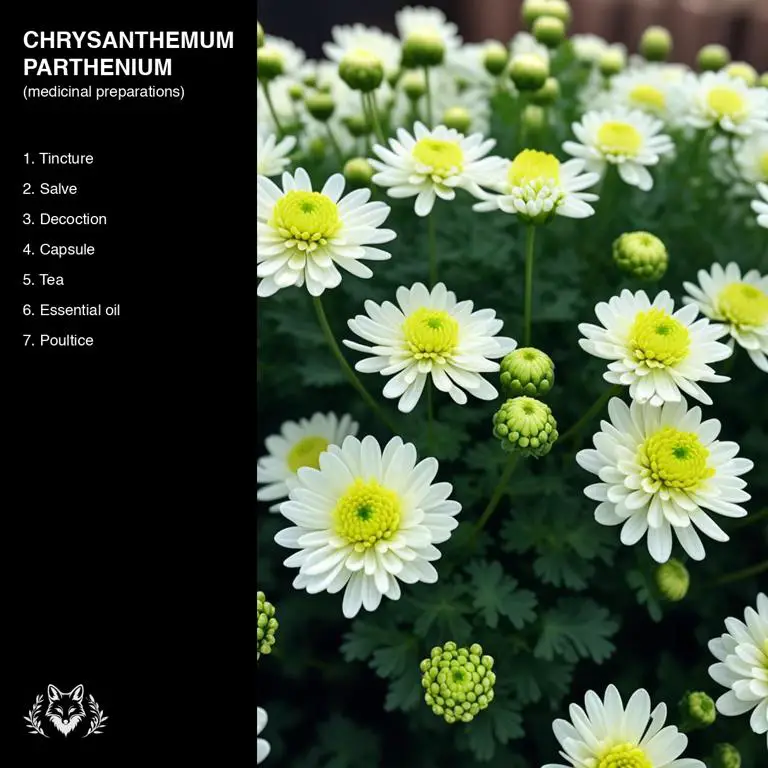
The list below provides more details on what are the most common medicinal preparations of Chrysanthemum parthenium and what are their main uses.
- Tincture: Tincture made from this plant is used to treat fever, inflammation, and rheumatism, and also as an antiseptic and anti-inflammatory agent.
- Salve: Salve made from this plant is used topically to treat fever, rheumatism, and skin conditions such as eczema and acne.
- Decoction: Decoction made from this plant is used to treat fever, rheumatism, and skin disorders such as eczema and acne, due to its anti-inflammatory and antiseptic properties.
- Capsule: Capsule made from this plant is used to treat fever, headache, and inflammatory conditions due to its anti-inflammatory and antipyretic properties.
- Tea: Tea made from this plant is used to treat fever, headache, and inflammatory conditions such as rheumatism and arthritis, as well as to relieve digestive issues and promote sweating.
- Essential Oil: Essential oil made from this plant is used to treat fever, headaches, and skin conditions, and as an antiseptic and anti-inflammatory agent.
- Poultice: Poultice made from this plant is a topical application used to treat skin irritations, such as eczema, burns, and insect bites, to reduce inflammation and promote wound healing.
The table that follows shows what are the most used parts of Chrysanthemum parthenium for each medicinal preparation.
| Preparation | Parts |
|---|---|
| Tincture | Flowers, Leaves |
| Salve | Flowers, Leaves |
| Decoction | Flowers, Leaves |
| Capsule | Flowers, Leaves |
| Tea | Flowers, Leaves |
| Essential oil | Flowers, Leaves |
| Poultice | Flowers, Leaves |
Tincture
Chrysanthemum parthenium tincture is a herbal preparation used to treat various conditions, including rheumatism, migraine, inflammation, cough, fever, sinusitis, and sore throat.
It is a common treatment, often found in herbal medicine cabinets and used by practitioners worldwide. The tincture has a sedative effect, calming the nervous system and reducing anxiety and restlessness. It is typically made with the flowers and leaves of the Chrysanthemum parthenium plant, which are combined with a solvent, usually ethanol or glycerin, to extract their active compounds.
The preparation process is moderately difficult, requiring attention to detail and the right balance of plant material to solvent ratio to produce a high-quality tincture.
Below you find an image of Chrysanthemum parthenium tincture.
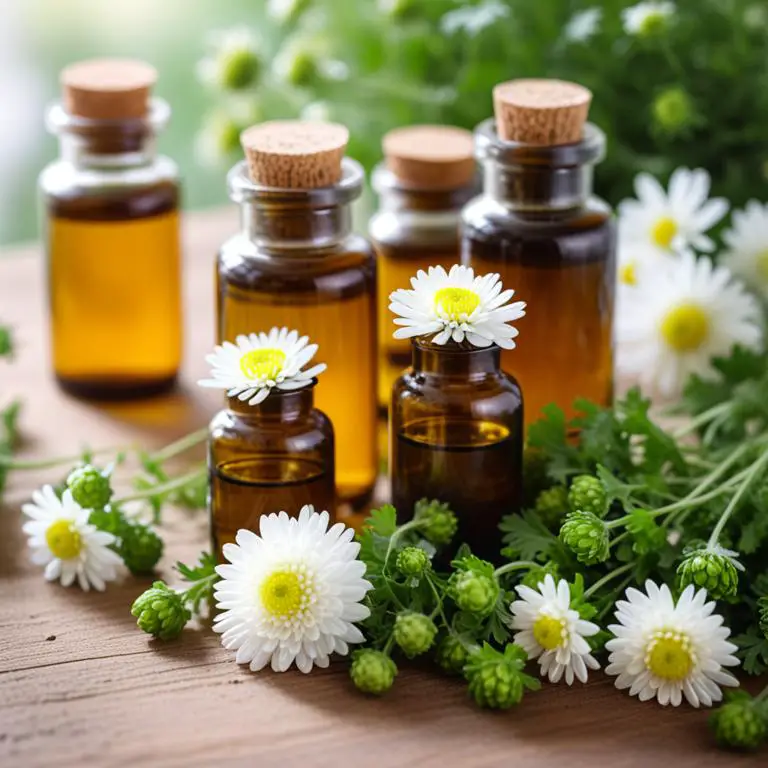
Below you find a 5-step quick procedure to make effective medicinal Chrysanthemum parthenium tincture.
- Gather fresh Chrysanthemum parthenium flowers and leaves, clean and dry them.
- Combine the flowers and leaves in a clean glass jar, making sure to pack them tightly.
- Cover the jar with a lid and let it sit for 2-4 weeks in a cool, dark place, shaking the jar daily.
- After the infusion period, strain the liquid through a cheesecloth or a coffee filter into a clean glass bottle.
- Store the Chrysanthemum parthenium herbal tincture in the refrigerator, protected from light and heat.
Salve
Chrysanthemum parthenium salve is a topical preparation used to treat burns, wounds, insect bites, scalds, skin irritation, rashes, itchiness and eczema.
It's a common remedy in traditional medicine, widely used for its therapeutic properties. This preparation has anti-inflammatory effects, which help to reduce redness and swelling in affected areas. Chrysanthemum parthenium salve is typically made from the flowers and leaves of the Chrysanthemum parthenium plant, which are rich in sesquiterpene lactones and other bioactive compounds.
However, its preparation requires expertise and specialized knowledge, as the plant's extracts need to be carefully processed and combined to achieve the desired efficacy.
Below you find an image of Chrysanthemum parthenium salve.
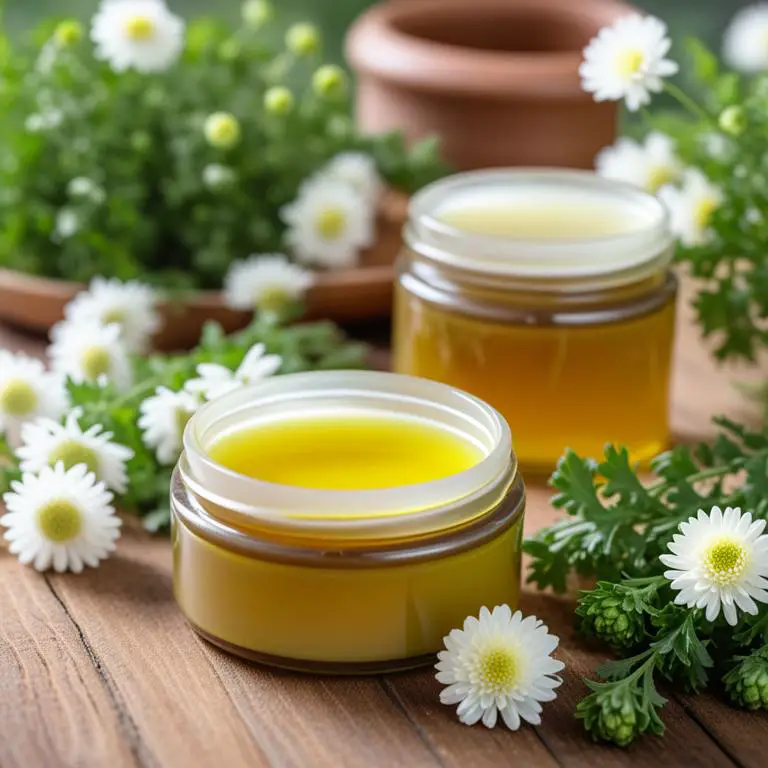
Below you find a 5-step quick procedure to make effective medicinal Chrysanthemum parthenium salve.
- Gather a sufficient amount of fresh Chrysanthemum parthenium flowers and leaves, and dry them thoroughly.
- Combine the dried flowers and leaves in a clean glass jar, and steep them in a carrier oil, such as coconut or olive oil, for several weeks, shaking the jar daily.
- Strain the oil through a cheesecloth or a coffee filter into another clean glass container, discarding the solids.
- Add a natural preservative, such as vitamin E oil or beeswax, to the infused oil to prevent spoilage and extend shelf life.
- Mix the infused oil with a skin-safe wax, such as beeswax or candelilla wax, and pour the mixture into a salve tin or container to create the herbal salve.
Decoction
Chrysanthemum parthenium decoction is used to treat fever, malaria, headache, inflammation, sore throat, rheumatism, diarrhea, tuberculosis and meningitis.
It is commonly used in traditional medicine. This decoction has anti-inflammatory and antimicrobial effects. It is made from the flowers and leaves of the Chrysanthemum parthenium plant.
Preparing the decoction requires boiling the plant parts in water, which is a moderately difficult process.
Below you find a 5-step quick procedure to make effective medicinal Chrysanthemum parthenium decoction.
- Gather fresh or dried flowers and leaves of Chrysanthemum parthenium.
- Clean and prepare the herbal material by washing it with water.
- Combine the flowers and leaves in a pot and add a sufficient amount of water.
- Boil the mixture over low heat for about 10-15 minutes, allowing the flavors to infuse.
- Strain the decoction and discard the solids, then let it cool before consumption.
Capsule
Chrysanthemum parthenium capsule is used to treat various conditions including migraine, herpes zoster, hypertension, diabetes, hyperlipidemia, gastritis, allergic rhinitis, and dyspepsia.
It's one of the most commonly used herbal preparations due to its widespread efficacy. One of the common effects of taking Chrysanthemum parthenium capsule is its ability to reduce inflammation and improve cardiovascular health. This preparation is typically made from the flowers and leaves of the Chrysanthemum parthenium plant, which are harvested and then processed into capsule form.
The process of making Chrysanthemum parthenium capsule is moderately difficult as it requires careful drying, grinding, and standardization of the plant material to ensure consistent potency and quality.
Below you find a 5-step quick procedure to make effective medicinal Chrysanthemum parthenium capsule.
- Gather fresh Chrysanthemum parthenium flowers and leaves from a trusted source.
- Dry the flowers and leaves in a well-ventilated area, either by air drying or using a dehydrator.
- Grind the dried flowers and leaves into a fine powder using a grinder or mortar and pestle.
- Mix the powdered flowers and leaves in a specific ratio to achieve the desired blend.
- Fill gelatin capsules with the blended powder and seal them to create the Chrysanthemum parthenium herbal capsules.
Tea
Chrysanthemum parthenium tea is a traditional herbal remedy used to treat hypertension, cough, diarrhea, fever, skin conditions, inflammation, rheumatism, asthma, anxiety, and fatigue.
It's one of the most commonly used herbal teas worldwide due to its widespread availability and long history of use. Drinking Chrysanthemum parthenium tea often results in a rapid drop in blood pressure and a decrease in stress levels.
The tea is typically made by infusing the flowers and leaves of the Chrysanthemum parthenium plant in hot water, a simple process that requires minimal preparation and equipment.
Below you find an image of Chrysanthemum parthenium tea.
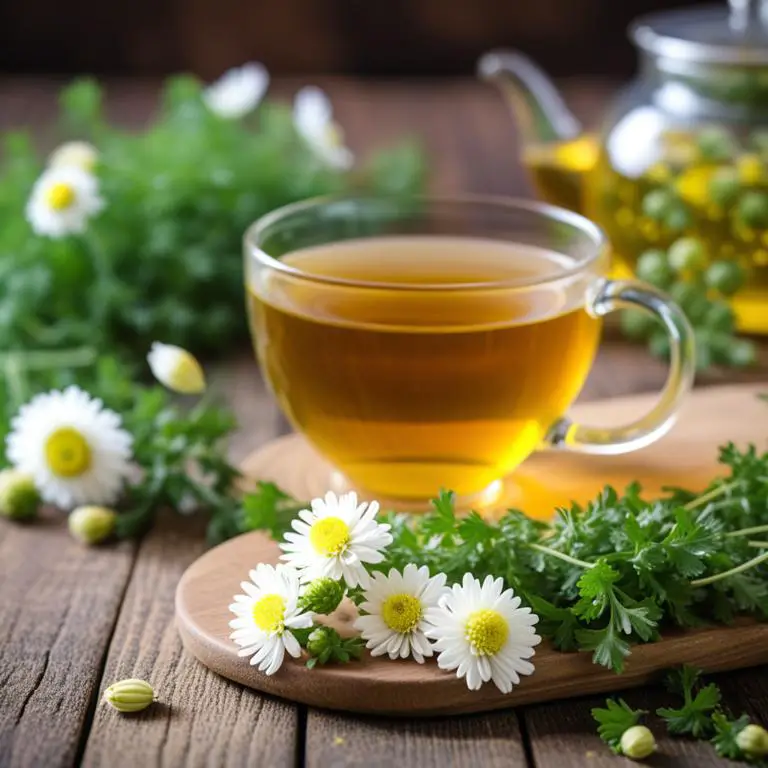
Below you find a 5-step quick procedure to make effective medicinal Chrysanthemum parthenium tea.
- Gather fresh or dried flowers and leaves of Chrysanthemum parthenium, and clean them thoroughly.
- Combine 1 tablespoon of the cleaned flowers and leaves in a tea infuser or a heat-resistant cup.
- Heat 1 cup of water to a boil, then carefully pour it over the flowers and leaves in the infuser or cup.
- Allow the mixture to steep for 5-7 minutes, or until the desired flavor and aroma are achieved.
- Strain the tea and serve it hot or chilled, depending on your preference.
Essential Oil
Chrysanthemum parthenium essential oil is used to treat itchy scalp, acne, eczema, psoriasis, skin irritation, rashes, and fungal infections.
It's a common ingredient in various herbal remedies and skincare products due to its widespread use. The oil has a common effect of reducing inflammation and promoting skin healing. Chrysanthemum parthenium essential oil is typically made from the flowers and leaves of the plant, which are steam-distilled to extract the oil.
The process of making this oil is considered moderately difficult, requiring some expertise and equipment to obtain a high-quality product.
Below you find an image of Chrysanthemum parthenium essential oil.
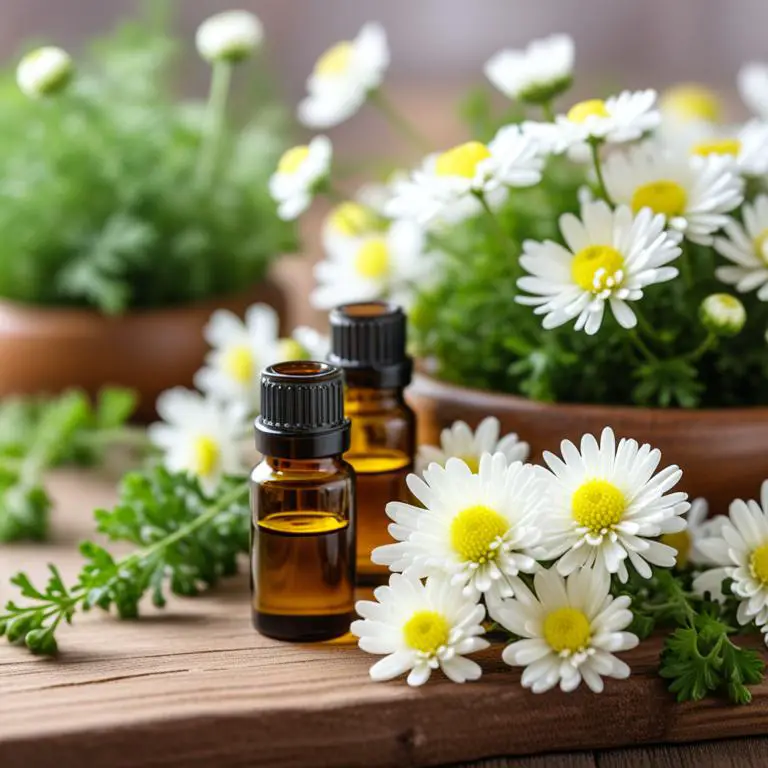
Below you find a 5-step quick procedure to make effective medicinal Chrysanthemum parthenium essential oil.
- Harvest and dry the flowers and leaves of the Chrysanthemum parthenium plant.
- Gently crush the dried flowers and leaves to release their oils and essence.
- Combine the crushed plant material with a carrier oil in a clean glass container.
- Steep the mixture in a cool, dark place, shaking it occasionally, for several weeks.
- Strain the mixture through a cheesecloth or a coffee filter into a separate container to obtain the herbal essential oil.
Poultice
Chrysanthemum parthenium poultice is used to treat burns, insect bites, rashes, fever, and skin infections.
It's a common preparation in herbal medicine, often employed due to its effectiveness. A common effect of the poultice is its ability to reduce inflammation and promote healing. The poultice is typically made with the flowers and leaves of the Chrysanthemum parthenium plant, which are combined and applied directly to the affected area.
The process of making a Chrysanthemum parthenium poultice can be moderately difficult, requiring some skill and attention to detail to prepare the plant material correctly.
Below you find a 5-step quick procedure to make effective medicinal Chrysanthemum parthenium poultice.
- Harvest fresh Chrysanthemum parthenium flowers and leaves, making sure they are clean and free of dirt.
- Gather a mortar and pestle, and grind the flowers and leaves into a fine paste.
- Mix the ground flowers and leaves with a small amount of water to create a smooth, consistent paste.
- Apply the poultice to the affected area, using a cloth or gauze to hold it in place.
- Leave the poultice on the affected area for several hours or overnight, and then remove and discard it.
What are the possible side effects of Chrysanthemum parthenium if used improperly?
The most common side effects Chrysanthemum parthenium gives people when used improperly are listed below, along with a brief explanation.
- Experiencing Nausea: Ingestion of Chrysanthemum parthenium causes stomach upset leading to vomiting and nausea.
- Developing Diarrhea: Ingestion of Chrysanthemum parthenium causes gastrointestinal irritation leading to diarrhea.
- Suffering From Vomiting: Ingestion of Chrysanthemum parthenium causes gastric irritation leading to vomiting.
- Exhibiting Skin Rash: Contact dermatitis, characterized by redness, itching, and blistering, occurs after skin exposure to Chrysanthemum parthenium.
- Showing Allergic Reaction: Contact dermatitis, rhinitis, and asthma symptoms occur after exposure to Chrysanthemum parthenium.
- Experiencing Headache: Contact dermatitis of scalp leads to headache due to skin irritation and inflammation.
- Displaying Dizziness: Ingestion of Chrysanthemum parthenium causes a drop in blood pressure leading to dizziness due to its vasodilatory properties.
- Experiencing Liver Damage: Chrysanthemum parthenium contains sesquiterpene lactones which cause hepatotoxicity leading to liver damage.
- Suffering From Kidney Failure: Chrysanthemum parthenium contains sesquiterpene lactones that can cause acute kidney injury leading to kidney failure
- Experiencing Seizure: Chrysanthemum parthenium contains sesquiterpene lactones that can induce seizures in some individuals, particularly at high doses.
What are the precautions to take before using Chrysanthemum parthenium medicinally?
The precautions to take before using Chrysanthemum parthenium medicinally are to consult a doctor before use, especially for individuals with pre-existing health conditions.
Before using, it is crucial to monitor blood pressure as Chrysanthemum parthenium may exacerbate hypertension. Furthermore, it is contraindicated in pregnancy and breastfeeding due to potential harm to the fetus or infant. To ensure safe and effective treatment, start with low doses and gradually increase as needed, while also being mindful of potential interactions with other medications.
Patients should have their kidney and liver function checked periodically, and avoid using Chrysanthemum parthenium in children, as well as report any side effects to their healthcare provider, who may also need to supervise the use of this herb, particularly if the patient is prone to allergic reactions.
The most important precautions you must take before using Chrysanthemum parthenium for medicinal purposes are listed below, along with a brief explanation.
- Consult A Doctor Before Use: Use under medical supervision due to potential interactions with medications.
- Monitor Blood Pressure: Chrysanthemum parthenium extracts cause a significant decrease in blood pressure in individuals with hypertension.
- Avoid In Pregnancy And Breastfeeding: Chrysanthemum parthenium may cause uterine stimulation and potentially harm fetal development.
- Start With Low Doses: Initiate treatment with small amounts of Chrysanthemum parthenium to monitor for adverse effects and adjust dosage accordingly.
- Interact With Other Meds: Chrysanthemum parthenium may cause additive effects when taken with other medications, such as anticoagulants, diabetes medications, and blood thinners, increasing the risk of bleeding or hypoglycemia.
- Kidney And Liver Function Check: Monitor kidney and liver function in patients taking Chrysanthemum parthenium due to potential hepatotoxicity and nephrotoxicity.
- Avoid In Children: Chrysanthemum parthenium essential oil can cause seizures in children due to its pyrethrin content.
- Allergic Reactions Possible: Some individuals exhibit allergic reactions to Chrysanthemum parthenium.
- Use Under Medical Supervision: Administered under the guidance of a qualified healthcare provider due to potential interactions and adverse effects.
- Report Side Effects: Inform healthcare provider about any side effects or allergic reactions.
